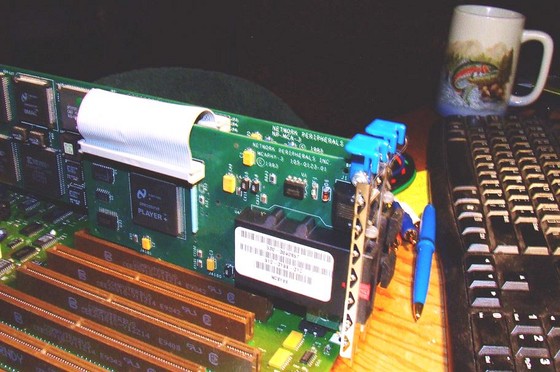|
@0069.ADF Network Peripherals FDDI Adapter
0826_01 Install Guide for F3019, F3059, F3069, and
F3079 FDDI Adapters
NP_0112-08 Diags, NW 4/3, ODI, NT v3.11 2/2/94,
NDIS 3.0, DOS\OS2 ODI & NDIS 2.0.1
Many thanks to Andreas Kohl for pulling these from the mists of
time.
NPMCA.SYS NT 4.0 Driver ver. 3.15 (10/14/96)
(compressed as \i386\NPMCA.SY_)
NP_mca-lm Enhanced NIF for use with
IBM LAN Systems products
Note from Andreas: The zip files contains my modification for
use with IBM OS/2 networking, simply copy it's content to \IBMCOM\MACS
or to a floppy (if you want to test, how LAPS is copying this files). (thanks
to Andreas again for writing it!)
NP-MCA-3 Base Card
MCAPHY-3 DAS Side Card
ADF Sections
NP-MCA-3 105-0122-01

D1 Port Activity LED?
JP3 Top row, 25 pin header
JP4 Middle row, 25 pin header
JP5 20 pin header
JP6 Bottom row, 25 pin header
JP7 Pads for 6 pin header
U1-4 CXK58257AM-70L (on back)
U5 610-0166-01D
U9 NS S9452AG CMT Process
|
U21 NS DP83257VF Player +
U24 XILINX XC3042-70
U25 XILINX XC3042-70
U27 NS DP83261AVF MAC
U33 20 pin PLCC 01741.01D1D
U506 XILINX XC3042-100
U560 Symbios Logic 86C05A
Y1 12.500MHz osc
Y3 40.000 MHz xtal
|
DP83265A BSI-2TM Device (FDDI
System Interface) My guess what U9 REALLY is...
DP83261AVF BMAC Device (FDDI
Media Access Controller)
Rightmost pin on JP4 was removed (towards the slot bracket), this assures
the 50 pin cable from the side card is attached in only one way.
MCAPHY-3 105-0123-01

D1 Port activity LED?
J1 Optical bypass
JP3 25-pin header
JP4 25-pin header
|
JP5 20-pin header
JP6 pads for 25-pin header
U21 NS DP83257VF Player +
U41 610-0166-01D Transceiver
|
JP4 25-pin header, rightmost pin missing
JP5 20-pin header, lower left pin missing
DP83257 (FDDI Physical Layer Controller)
The DAS side card's cables will only fit in the base card if the side
card is to the right of the base card. It was easier to put the cables
on before trying to put the adapters in the MCA slots because you can have
both cards "flat". For us with NP-MCA-3 cards that were banged about some,
check the (exposed!) pin header on the base card. Some of the pins may
have been bent some, and trying to install the cable will be frustrating.

Gereon Wenzel:
Looks like its time to start my work on a FDDI Howto/FAQ?
No need someone else already did... Google is your friend!
http://www2.rad.com/networks/1995/fddi/fddi.htm
http://www.cicese.mx/~aarmenta/frames/redes/fddi/FDDIFAQ.html
http://www.cisco.com/univercd/cc/td/doc/cisintwk/ito_doc/fddi.htm
> Does anyone have a manual for this card?
Not sure if this one matches your cards?
http://www.enterasys.com/support/manuals/hardware/0826_01.pdf
David Ress:
IIRC, Win95 has built in support. NT 4.0 has built in support
(and auto-detects it, unlike the SK-Net FDDI adapter). Uses Npmca.sys for
the driver. I tried a while ago to find the diagnostic program for the
adapter and failed. Anyone? Editor - Andreas Kohl foundt them...
NP has since been bought out, and the new company has extremely limited
support for NP hardware, mostly switch related. Nothing microchannel. Still,
for FDDI networks, it is my preferred adapter.
Support for Multi Channel Architecture
The BSI-2 device provides three Input Channels and two
Output Channels, which are designed to operate independently and concurrently.
They are separately configured by the user to manage the reception or transmission
of a particular
ADF Sections @0069h Network Peripherals FDDI Adapter
Map 512 I/O Address Range
This selects the 512 I/O address space of the adapter
<"5400h thru 55FFh">,
5C00 - 5DFF, 5E00 - 5FFF, 7400 - 75FF, 7600 - 77FF, 7C00 - 7DFF, 7E00 -
7FFF, D400 - D5FF, D600 - D7FF, DC00 - DDFF, DE00 - DFFF, F400 - F5FF,
F600 - F7FF, FC00 - FDFF, FE00 - FFFF
Modes and Interrupt Level
Warning! DATA STREAMING
MODE should be selected ONLY if you are sure that this machine supports
data streaming. This will result in better performance. SLOW
MODE should be selected if this FDDI adapter is installed in
an older Model 80 that has not had the IBM EC applied. (Ed.
I think this refers to the non-busmaster
capable planars)
<"Normal Mode & Interrupt
3">, Normal/Int5, Normal/Int10, Normal/Int15, Data Streaming Mode
& Interrupt 3, Data Streaming/Int5, Data Streaming/Int10, Data Streaming/Int15,
Slow Mode & Interrupt 3, Slow/Int5, Slow/Int10, Slow/Int15
Arbitration Level
Using arbitration levels, this adapter accesses memory
directly without burdening the computer's main microprocessor. An arbitration
level of 0 has the highest priority, and increasing levels have corresponding
decreased priority.
<"Level_1">, 0, 2, 3,
4, 5, 6, 7, 8, 9, 10, 11, 12, 13, 14
Map 8K Memory Address Range
This selects the 8K memory space of the adapter
<"0C0000h thru 0C1FFFh">,
0C2000 - 0C3FFF, 0C4000 - 0C5FFF, 0C6000 - 0C7FFF, 0C8000 - 0C9FFF, 0CA000
- 0CBFFF, 0CC000 - 0CDFFF, 0CE000 - 0CFFFF, 0D0000 - 0D1FFF, 0D2000 - 0D3FFF,
0D4000 - 0D5FFF, 0D6000 - 0D7FFF, 0D8000 - 0D9FFF, 0DA000 - 0DBFFF, 0DC000
- 0DDFFF, 0DE000 - 0DFFFF, 0E0000 - 0E1FFF, 0E2000 - 0E3FFF, 0E4000 - 0E5FFF,
0E6000 - 0E7FFF, 0E8000 - 0E9FFF, 0EA000 - 0EBFFF, 0EC000 - 0EDFFF, 0EE000
- 0EFFFF
|